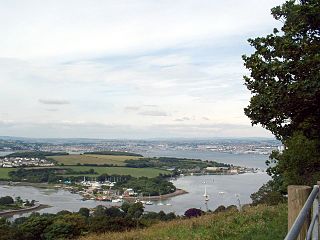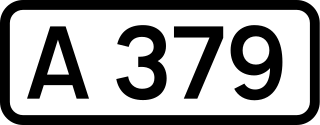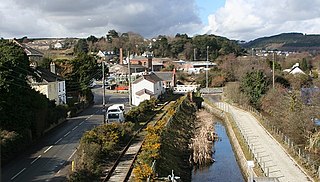
The Hamoaze is an estuarine stretch of the tidal River Tamar, between its confluence with the River Lynher and Plymouth Sound, England.

The Torpoint Ferry is a car and pedestrian chain ferry connecting the A374 which crosses the Hamoaze, a stretch of water at the mouth of the River Tamar, between Devonport in Plymouth and Torpoint in Cornwall. The service was established in 1791 and chain ferry operations were introduced by James Meadows Rendel in 1832.

The Tamar Bridge is a suspension bridge over the River Tamar between Saltash, Cornwall and Plymouth, Devon in southwest England. It is 335 metres (1,099 ft) long, running adjacent the Royal Albert Bridge, and part of the A38, a main road between the two counties.

The Tamar is a river in south west England, that forms most of the border between Devon and Cornwall. A part of the Tamar Valley is a World Heritage Site due to its historic mining activities.

The A38, parts of which are known as Devon Expressway, Bristol Road and Gloucester Road, is a major A-class trunk road in England.

Torpoint is a civil parish and town on the Rame Peninsula in southeast Cornwall, England, United Kingdom. It is situated opposite the city of Plymouth across the Hamoaze which is the tidal estuary of the River Tamar. Torpoint had a population of 8,457 at the 2001 census, decreasing to 8,364 at the 2011 census. Two electoral wards also exist. Their combined populations at the same census were 7,717.

Saltash is a town and civil parish in south Cornwall, England, United Kingdom. It had a population of 16,184 in 2011 census. Saltash faces the city of Plymouth over the River Tamar and is popularly known as "the Gateway to Cornwall". Saltash’s landmarks include the Tamar Bridge which connects Plymouth to Cornwall by road, and the Royal Albert Bridge. The area of Latchbrook is part of the town.
Saltash Passage is on the Devon side of the River Tamar, opposite Saltash. It is part of St Budeaux, an area of Plymouth in Devon. Saltash Passage lies at the northern end of Wolseley Road, previously known as Ferry Road. The local railway station continues to be known as Ferry Road Station. Saltash Passage is named after the ferry route that carried passengers and vehicles between Saltash in Cornwall and Plymouth, across the River Tamar. The ferry became uneconomic following the construction of the Tamar Bridge in 1961. Saltash Passage is a popular leisure destination for the locals as well as tourists in summer.

Devonport railway station serves the Devonport area of Plymouth in Devon, England. It is 247 miles 15 chains (397.8 km) from London Paddington via Bristol Temple Meads. It is managed by Great Western Railway.

St Budeaux Victoria Road railway station is a suburban station in St Budeaux, Plymouth, Devon, England. The station is managed and served by Great Western Railway.

The Cornwall Railway was a 7 ft 1⁄4 in broad gauge railway from Plymouth in Devon to Falmouth in Cornwall, England, built in the second half of the nineteenth century. It was constantly beset with shortage of capital for the construction, and was eventually forced to sell its line to the dominant Great Western Railway.

The A379 is a road in the English county of Devon. It links points on the edges of that county's two principal cities, Exeter and Plymouth, by an indirect and largely coastal route. The A38 provides a faster and more direct inland route between Exeter and Plymouth, whilst the A380 provides a similarly faster route between Exeter and the Torbay area. However the A379 serves many small coastal communities and ports along the coast. The indented nature of the South Devon coast means that the road is usually out of sight of the sea, but the many rivers and estuaries are crossed by bridges and, in one case, a cable ferry.

The Forgotten Corner of Cornwall is a geographical area of South East Cornwall, Great Britain. It includes the Rame Peninsula and the town of Torpoint, as well as villages like Antony, Downderry, Polbathic, Portwrinkle and Widegates.

B roads are numbered routes in Great Britain of lesser importance than A roads. See the article Great Britain road numbering scheme for the rationale behind the numbers allocated.

The evolution of transport in Cornwall has been shaped by the county's strong maritime, mining and industrial traditions and much of the transport infrastructure reflects this heritage.

The network of railways in Plymouth, Devon, England, was developed by companies affiliated to two competing railways, the Great Western Railway and the London and South Western Railway. At their height two main lines and three branch lines served 28 stations in the Plymouth area, but today just six stations remain in use.
The A38 is a major trunk road running from the south-east of Bodmin in Cornwall to Mansfield in Nottinghamshire. At 292 miles (470 km), it is the longest 'A' road entirely within England.

The Cremyll ferry is a foot passenger ferry across the Hamoaze from Admirals Hard in Stonehouse, Plymouth, Devon to Cremyll in Cornwall. It is operated by Plymouth boat Trips, and runs approximately every 30 minutes, with a 8-minute crossing time.
Devon League 2 was an English level ten rugby union league for clubs based in Devon; with one exception. The champions and runners-up are promoted to Devon League 1, and since the cancellation of Devon League 3 in 2003 there was no relegation as this is the lowest division in club rugby union within Devon.



















